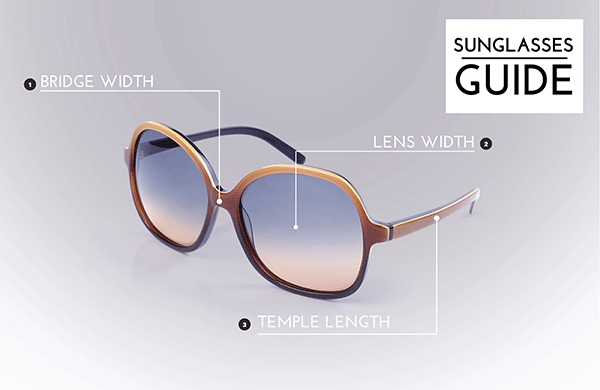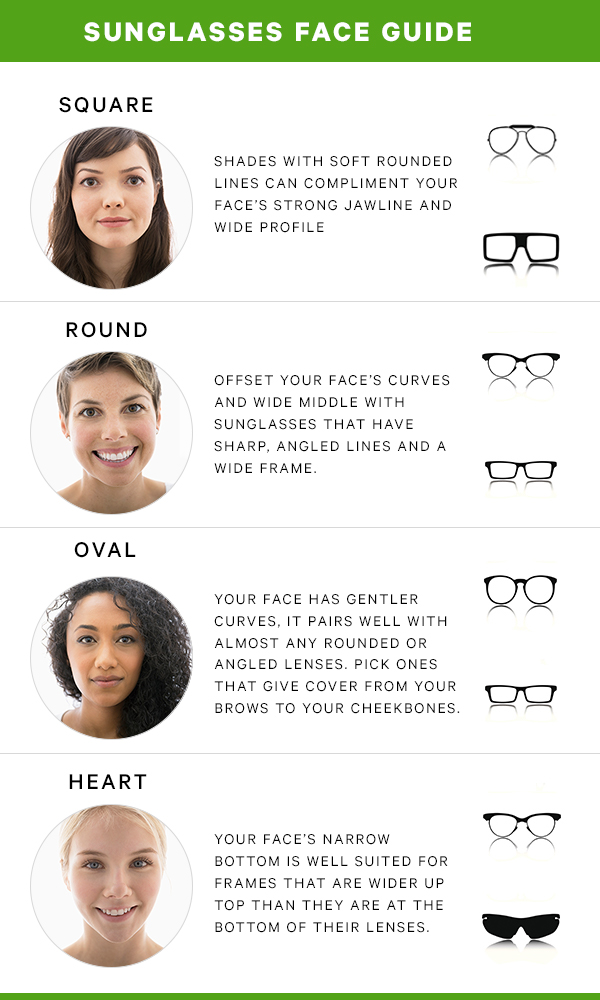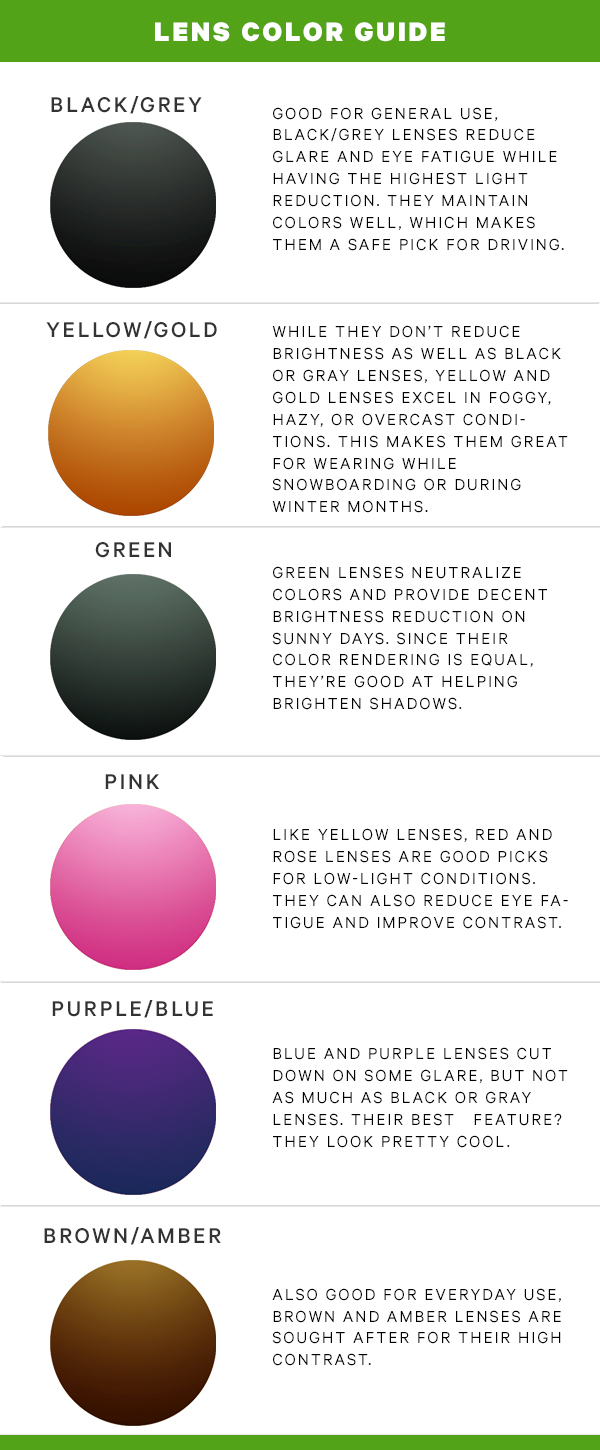
Sunglasses are one of fashion's most iconic accessories. Just imagine Audrey Hepburn's Holly Golightly standing in front of the Tiffany's window without her black cat-eyes. Or the Blues Brothers without their Wayfarers. Or Hunter S. Thompson without his yellow aviators.
Problem is, it can be hard to find your signature style when there are so many different types of sunglasses out there. And even if you do find a style you like, you still have to make sure they're right for your face shape and provide the right protection for your eyes. So, to make it easier to find your perfect pair of shades, we've created this guide covering everything from sunglass lenses to this summer's trendiest shapes.
Sunglasses Fit Guide
If you wear regular glasses, you probably already know what to look for when it comes to fitting specs to your face. If not, to find the best fit, you'll basically want to know three key measurements: bridge size, lens width, and temple length.

- Bridge width: typically ranges from 14mm to 24mm
- Lens width: typically ranges from 40mm to 62mm
- Temple length: typically ranges from 120mm to 150mm
Please note that these measurements are strictly for determining fit, not sunglasses coverage (there's plenty of oversized-style sunglasses made for smaller faces). Just remember: the larger the face, the larger the measurement.
How to Measure Your Face
If you already wear eyeglasses, you likely have a handy shortcut. Look on the inside of the temple arm of your glasses for three numbers indicating frame dimensions. Those numbers are:
[lens width] x [bridge width] x [temple length]
Alternatively, your frame may have lens width and bridge width printed on the nose bridge. When shopping for sunglasses, use these dimensions as your guide. You'll have a leeway of 2 millimeters for each dimension, so a good fit doesn't need to be exact.
Measuring Bridge Width
Examine the bridge of your nose in the mirror. Where does it start? How wide or skinny does it get? Next, take a selfie of your side profile.
- If your bridge is low (level or below your pupils) and skinny, a small bridge size will work best
- If your bridge is high (above your pupils) and wide, a large bridge size will work best
- For any other combination of attributes, a medium-range number should provide a comfortable fit
Measuring Lens Width
While looking in the mirror, hold a ruler up so that it lines up with your temples. Measure the distance between them, then subtract 6 millimeters (the total average for the endpieces) and your bridge measurement. Halve the remainder and you have your lens width.
Measuring Temple Length
Temple arm length has the least variance of the three dimensions, so it's less important to get an exact measurement. Anything from 135 to 145 millimeters should be a safe bet.
Finding the Right Fit
Of course, sunglasses are worn only occasionally, so you don't necessarily need to be as meticulous in your fitting as you would with a pair of prescription glasses. You might find that you're pickier about the shape of your glasses, however, and choosing a pair of sunglasses that's right for your face shape can be a bit trickier. Below, we made a cheat sheet that shows the best sunglasses for four different face shapes.

Choosing the Right Sunglass Lenses
Lens characteristics such as material and color can have a great impact on how sunglasses will perform in different lighting conditions and environments. Find out which material and color works best for you:
Materials
- Polycarbonate: These lenses are lightweight and tough, and they offer good optical clarity. They also resist shattering more effectively than glass lenses, making them a good pick for active wear.
- Acrylic: These lenses won't give you the impact-resistance of polycarbonate or the optical clarity of glass, but they're generally less expensive, so they're a good choice for shades you'll only be using occasionally.
- Glass: Glass lenses give you the highest level of clarity, and they resist scratching better than most materials. They do tend to be heavier than polycarbonate lenses, and they can form spiderweb-like cracks if dropped.

Types of Sunglasses: How to Rock These Four Distinct Styles
Now that you know what to look for in terms of shape and lens color, it's time for the fun part: shopping. These four distinct types of sunglasses are on trend for this summer, but are actually pretty timeless, in our opinion. Once you've settled on a style, just click the banner below and use the search bar to browse all the different sunglasses available on Groupon. Our inventory is constantly changing, so you'll always have plenty of shades to choose from.
Statement Frames

Photo by Mark Mills, Groupon
The key to wearing these styles is easy—let them steal the spotlight, whether it's with an unexpected shape or with embellishments. In other words, try pairing these with minimalist makeup and a simple outfit.
The Classics

Thanks to their clean, simple shapes, these styles look as good today as they did 50 years ago. They're versatile, too. Many of them, including Wayfarers, classic rounds, aviators, and Clubmasters, look equally great on men or women. To set yours apart, look for details like colored lenses or two-tone frames.
Oversized Frames

Come hangover or high noon, these are the kind of shades you can hide behind. To keep them from overwhelming your face, pay extra attention to choosing a frame that complements your face shape.
Unexpected Textiles

Not every pair of shades has to be made from metal or plastic. Other materials are becoming increasingly popular, including rubber, leather, wood, and eco-friendly bamboo.
